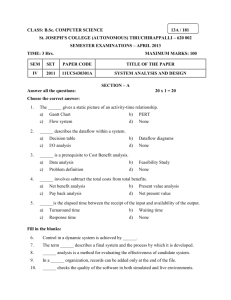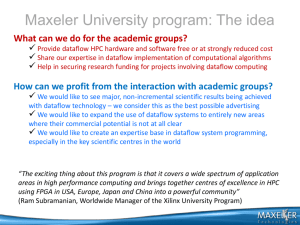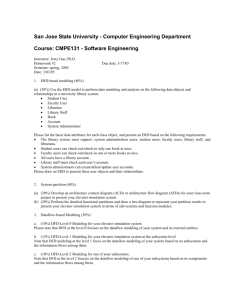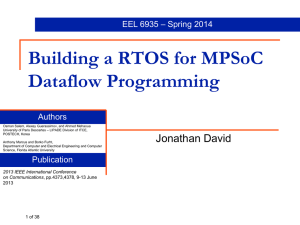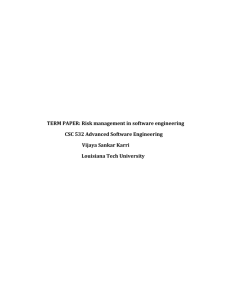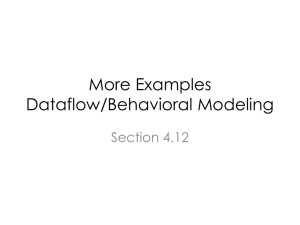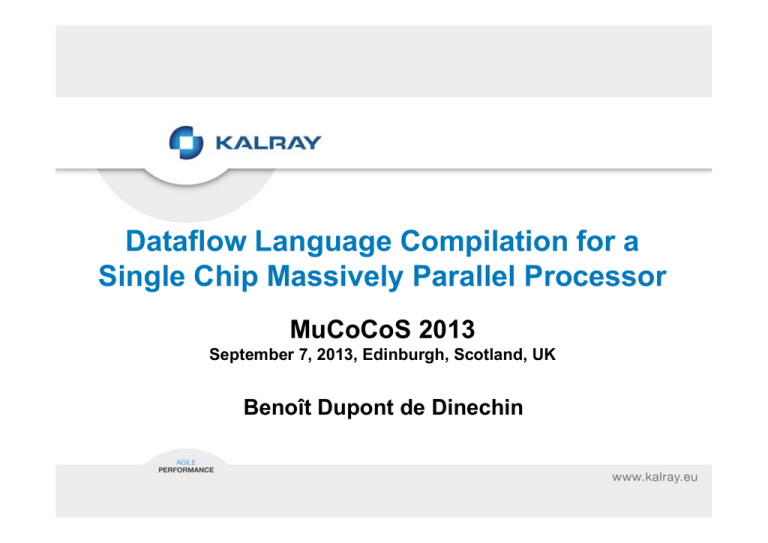
Dataflow Language Compilation for a
Single Chip Massively Parallel Processor
MuCoCoS 2013
September 7, 2013, Edinburgh, Scotland, UK
Benoît Dupont de Dinechin
Outline
Kalray MPPA® Products
Kalray SigmaC Language Features
Kalray SigmaC Language Toolchain
Related Dataflow Languages and Toolchains
Kalray MPPA® Application Examples
Conclusions
2013 – Kalray SA All Rights Reserved
MuCoCoS 2013
2
Kalray MPPA® Products
High performance, low power singlechip massively parallel processors
C/C++ based Software Development Kit
(SDK) for massively parallel programing
Development platform
Reference Design Board
2013 – Kalray SA All Rights Reserved
MuCoCoS 2013
3
Kalray MPPA®-256 Processor with CMOS 28nm TSMC
256 VLIW processing engine cores + 32 VLIW resource management cores
High processing performance
700 GOPS – 230 GFLOPS SP
Low power consumption
High execution predictability
High-level programming models
Available since November 2012
2013 – Kalray SA All Rights Reserved
MuCoCoS 2013
PCI Gen3, Ethernet 10G, NoCX
4
MPPA MANYCORE Processor Roadmap
Architecture scalability for high performances and low power
2012
28nm
2014
28nm
20nm
2015
16nm
MPPA®-1024
Low Power
12W
MPPA®-256 V1
MPPA®-256 V2
Low Power
5W / 2.6W
MPPA®-64
Very Low Power
1.8W / 0.6W
Idle 75mW
1st core generation
2nd core generation
3rd core generation
50 GFLOPS/W
80 GFLOPS/W
100 GFLOPS/W
2013 – Kalray SA All Rights Reserved
MuCoCoS 2013
5
MPPA®-256 Processor Hierarchical Architecture
VLIW Core
Instruction Level
Parallelism
2013 – Kalray SA All Rights Reserved
Compute Cluster
Thread Level
Parallelism
MuCoCoS 2013
Manycore Processor
Process Level
Parallelism
6
MPPA®-256 VLIW Core Architecture
Data processing code
Byte memory alignment
Standard & effective FPU
Configurable bitwise logic
Hardware looping
System & control code
MMU
single memory port
function unit clustering
no
Execution predictability
Fully timing compositional core
LRU caches, low miss penalty
5-issue VLIW architecture
Predictability & energy efficiency
32-bit/64-bit IEEE 754 FPU
MMU for rich OS support
2013 – Kalray SA All Rights Reserved
Energy and area efficiency
7-stage instruction pipeline, 400MHz
Idle modes and wake-up on interrupt
MuCoCoS 2013
7
MPPA®-256 Compute Cluster
Multi-banked parallel memory
38,4GB/s of bandwidth @400MHz
Reliability
ECC in the shared memory
Parity check in the caches
Faulty cores can be switched off
Predictability
Multi-banked shared memory with
interleaved or blocked address map
Low power
16 PE cores + 1 RM core
NoC Tx and Rx interfaces
Debug Support Unit (DSU)
2 MB of shared memory
2013 – Kalray SA All Rights Reserved
Memory banks with low power mode
Voltage scaling
MuCoCoS 2013
8
MPPA®-256 Clustered Memory Architecture
20 memory address spaces
Eth1 I/O Subsystem
Eth0 I/O Subsystem
PCI0 I/O Subsystem
PCI1 I/O Subsystem
2013 – Kalray SA All Rights Reserved
MuCoCoS 2013
16 compute clusters
4 I/O subsystems with direct access
to external DDR memory
Dual Network-on-Chip (NoC)
Data NoC & Control NoC
Full duplex links, 4B/cycle
2D torus topology + extension links
Unicast and multicast transfers
Data NoC QoS
Flow control and routing at source
Guaranteed services by application
of network calculus
Oblivious synchronization
9
MPPA®-256 Data NoC Guaranteed Services
Source traffic regulation using (σ, ρ)
A packet flow obeys (σ, ρ) if for any time interval τ the number of packets
is not greater than σ + ρτ
The initial (σ, ρ) is set at the Tx Data NoC interface
Packets
σ+ρ t
σ
σ
Time
2013 – Kalray SA All Rights Reserved
MuCoCoS 2013
10
MPPA®-256 Processor I/O Interfaces
DDR3 Memory interfaces
PCIe Gen3 interface
1G/10G/40G Ethernet interfaces
SPI/I2C/UART interfaces
Universal Static Memory Controller
(NAND/NOR/SRAM)
GPIOs with Direct NoC Access
(DNA) mode
NoC extension through Interlaken
interface (NoC Express)
2013 – Kalray SA All Rights Reserved
MuCoCoS 2013
11
MPPA® Architecture Compared to other Manycores
NVIDIA, ATI, ARM generalize the GPU architecture into GP-GPU
Streaming multiprocessors that share a cache and DDR memory
Each stream multiprocessor operates multi-threaded cores in SIMT
CUDA or OpenCL data parallel kernel programming models
Cavium, Tilera TILE Gx, Intel MIC support shared coherent memory
Thread-based parallel programming (POSIX threads, OpenMP)
Non uniform memory access (NUMA) times, challenging cache design
Kalray MPPA® extends the supercomputer clustered architecture
Clustered memory architecture scales to > 1M cores (BlueGene/Q)
Low energy per operation, high execution predictability
Stand-alone operation with I/O, low-latency processing
2013 – Kalray SA All Rights Reserved
MuCoCoS 2013
12
Kalray Software Development Kit
MPPA ACCESSCORE – MPPA ACCESSLIB
Today
Q4 2013
This talk
Standard C/C++
Programming
Environment
Dataflow
Programming
FPGA Style
Simulators,
Profilers, Debuggers
& System Trace
POSIX-Level
Programming
DSP Style
Operating Systems &
Device Drivers
Streaming
Programming
GPU Style
2013 – Kalray SA All Rights Reserved
MuCoCoS 2013
13
Dataflow Models of Computation
Kahn Process Networks (KPN) [Kahn 1974]
Sequential “processes” connected through FIFO “channels”
Blocking “read”, non blocking “write” on channels
Processes are also called “actors” or “agents”
Determinacy of results, independent of firing sequence
A1
A2
A4
A3
A6
channels
processes
2013 – Kalray SA All Rights Reserved
A5
MuCoCoS 2013
14
Dataflow Models of Computation
Dataflow Process Networks (DPN) [Lee & Parks 1995]
KPN with functional actor firing (no persistent agent state)
KPN with sequential firing rules (can be tested in a pre-defined
order using only blocking reads)
Synchronous Dataflow [Benveniste et al. 1994]
Clocks are associated with tokens carried by the channels
Static Dataflow (SDF) [Lee & Messerschmitt 1987]
Agents producing and consuming a constant number of tokens
Single-rate SDF is known as Homogenous SDF (HSDF)
Cyclo-Static Dataflow (CSDF) [Lauwereins 1994]
A cyclic state machine unconditionally advances at each firing
Known number of tokens produced and consumed for each state
2013 – Kalray SA All Rights Reserved
MuCoCoS 2013
15
Dataflow Programming
Environment
Computation blocks and communication graph written in C
Cyclostatic data production & consumption
Firing thresholds of Karp & Miller
Dynamic dataflow extensions
Language called Sigma-C
Automatic mapping on
MPPA® memory, computing,
& communication resources
2013 – Kalray SA All Rights Reserved
MuCoCoS 2013
16
Outline
Kalray MPPA® Products
Kalray SigmaC Language Features
Kalray SigmaC Language Toolchain
Related Dataflow Languages and Toolchains
Kalray MPPA® Application Examples
Conclusions
2013 – Kalray SA All Rights Reserved
MuCoCoS 2013
17
Sigma-C Agent Example
agent Inverter()
{
agent keyword followed
by the name of the agent
interface section for input/
output channels
interface
{
in<unsigned char> input; /*< input byte stream */
out<unsigned char> output; /*< output byte stream */
spec{input; output};
state machine specification for
data production & consumption
}
void invert (void) exchange (input pel_in, output pel_out)
{
pel_out = 255 - pel_in;
}
void start ()
{
invert();
}
exchange keyword flags
direct operations on input
/ output channels
standard C code within the agent
start function is an infinite loop
}
2013 – Kalray SA All Rights Reserved
MuCoCoS 2013
18
Example of Cyclostatic Specs
spec{(5){input}; {input; output}};
void fn1 (void) exchange (input i)
{
/* Function code */
}
5 input transitions before processing
another input and firing output
void fn2 (void) exchange (input i, output o)
{
/* Function code */
}
void start ()
{
int i,
for (i=0; i<5; i++) {
fn1();
}
fn2();
}
2013 – Kalray SA All Rights Reserved
input
MuCoCoS 2013
[5,1]
A1
[0,1]
output
19
Example of Cyclostatic Specs
spec{{input; output1}; {input; output2}};
void fn1 (void) exchange (input i, output1 o)
{
/* Function code */
}
Two exchange functions,
one for each spec state
void fn2 (void) exchange (input i, output2 o)
{
/* Function code */
}
output1
void start ()
{
fn1();
fn2();
}
[1,0]
input
[1,1]
Consume one input at a time
2013 – Kalray SA All Rights Reserved
MuCoCoS 2013
A1
Send every
other input
output2 to a different
output (split)
[0,1]
20
Pre-Loaded Tokens in Channels
At program startup, some channels may be non-empty
Required for the liveness of some dataflow graphs
void preload(input_channel, int token_nbr, int data_size, void *input_data);
1
1
B
0
2
1
1
B
A
A
0
2
2
1
2
3
3
2013 – Kalray SA All Rights Reserved
1
3
1
C
B
BACBA
2
2
2
BACBA
0
1
C
B
1
A
0
2
MuCoCoS 2013
3
3
C
CBA
2
3
1
DEADLOCK
2
2
2
1
3
A
3
1
3
1
C
B
A
0
2
2
2
2
3
21
3
C
Generalization of Karp & Miller Thresholds
agent Filter()
{
Agent can access 6 tokens for
reading but only 1 token is
consumed at each transition
interface
{
in<unsigned char> input;
out<unsigned char> output;
spec{ {input[1:5]; output} };
}
void
start (void) exchange (input i[1:5], output o)
{
o = (i[0] + i[1] + i[2] + i[3] + i[4] + i[5])/3;
}
}
Consumed in
1st transition
Accessible in 1st transition
1 2 3 4 5 6 7 8 9 10
Consumed in
2nd transition
2013 – Kalray SA All Rights Reserved
input stream
Accessible in 2nd transition
MuCoCoS 2013
22
Instanciating and Connecting Agents
The « map » section of « subgraphs »
subgraph Subgraph1 ()
{
interface
{
in<unsigned char> input;
out<unsigned char> output;
Subgraph1
input
input
output
Agent1
input
output
output
Agent2
spec{input; output};
}
Agents are instanciated via the « new » keyword
map {
int N = 1024;
agent a1 = new Agent1();
agent a2 = new Agent2(N);
connect(input, a1.input);
connect(a1.output, a2.input);
connect(a2.output, output);
}
}
2013 – Kalray SA All Rights Reserved
« N » is an instance parameter for the agent
Agent interfaces are connected using « connect »
MuCoCoS 2013
23
Split and ComplexSplit System Agents
Agent2
Split: uniform scatter to N consumers
agent Split<elt_type>(int N, int k) {
interface {
in<elt_type> input;
out<elt_type> output[N];
spec {{input[k]; output[0][k]}; ...;
{input[k]; output[N-1][k]}};
}
}
r/3
Agent1
r
Split
ComplexSplit: cyclic scatter to N consumers
r/3
Agent2
r/3
Agent2
agent ComplexSplit<elt_type>(int N, unsigned int p, const unsigned int coefs[p]) {
interface {
in<elt_type> input;
out<elt_type> output[N];
spec {{input[coefs[0]]; output[0][coefs[0]]}; ...;
{input[coefs[p-1]]; output[p -1][coefs[p-1]]};
{input[coefs[0]]; output[p][coefs[0]]}; ... };
}
}
2013 – Kalray SA All Rights Reserved
MuCoCoS 2013
24
Join and ComplexJoin System Agents
Agent2
Join: uniform gather from N producers
agent Join<elt_type>(int N, int k) {
interface {
in<elt_type> input[N];
out<elt_type> output;
spec {{input[0][k]; output[k]}; ...;
{input[N-1][k]; output[k]}};
}
}
r/3
Agent3
r
r/3
Join
ComplexJoin: cyclic gather from N producers
Agent2
r/3
Agent2
agent ComplexJoin<elt_type>(int N, unsigned int p, const unsigned int coefs[p]) {
interface {
in<elt_type> input[N];
out<elt_type> output;
spec {{input[0][coefs[0]]; output[coefs[0]]}; ...;
{input[p-1][coefs[p-1]]; output[coefs[p-1]]};
{input[p][coefs[0]]; output[coefs[0]]}; ... };
}
}
2013 – Kalray SA All Rights Reserved
MuCoCoS 2013
25
Dup and Sink System Agents
Agent2
Dup: broadcast to N consumers
agent Dup<elt_type>(unsigned N, unsigned k) {
interface {
in<elt_type> input;
out<elt_type> output[N];
spec {{input[k]; output[][k]}};
}
}
Agent1
r
r
r
Dup
Agent3
r
Agent4
Sink: throw away tokens
agent Sink<elt_type>(unsigned int k) {
interface {
in<elt_type> input;
spec {input[k]};
}
}
2013 – Kalray SA All Rights Reserved
Agent1
MuCoCoS 2013
r
Sink
26
System Agent Inlining
Inlining saves buffer memory space and runtime copies
Requires that read and writes occur in middle of buffer
Data communication primitives are not FIFO operations
N/2-sized
Agent1
N-sized
Agent2
Dup
N/2-sized
N/2-sized
Agent2
Agent1
Agent3
N/2-sized
Agent3
Inlining constrainted by the ‘pointer equivalence’ principle
User code inside agents use regular pointers to access tokens
2013 – Kalray SA All Rights Reserved
MuCoCoS 2013
27
Outline
Kalray MPPA® Products
Kalray SigmaC Language Features
Kalray SigmaC Language Toolchain
Related Dataflow Languages and Toolchains
Kalray MPPA® Application Examples
Conclusions
2013 – Kalray SA All Rights Reserved
MuCoCoS 2013
28
Static Dataflow Graph Boundedness
2
A
Graph incidence matrix
2
2
M= 0
2
2
2
1
1
1
B
C
1
1
Balance equations
2 N(A) - N(B) = 0
N(B) - N(C) = 0
2 N(A) - N(C) = 0
2 N(A) - N(C) = 0
2013 – Kalray SA All Rights Reserved
-1
1
0
0
0
-1
-1
-1
Must be non-full rank
Any multiple of the repetition
vector N = |1 2 2|T satisfies the
balance equations
Solution to balance equations
ensures bounded execution
MuCoCoS 2013
29
Sequencing Static Dataflow Graphs
Symbolic execution of the dataflow graph
Execute one agent firing at a time
Find an ‘hyperperiod’, where each agent executes its number of
times in the repetition vector and where the channel token count
returns to the same values
Preloaded tokens in channels and firing thresholds may delay the
first occurrence of the hyperperiod
Symbolic execution of a balanced static dataflow graph
always succeeds, unless the graph is not alive
Take advantage of choice over ready agent firing to heuristically
optimize objectives such as maximum buffer use
2013 – Kalray SA All Rights Reserved
MuCoCoS 2013
30
Dataflow Graph and Dependence Graph
Static Dataflow graph execution can be interpreted
A
3
B
3
C
Efficient parallel execution is achieved by unfolding a
dependence graph that ensures correct buffer accesses
True data dependence arcs and buffer size feedback arcs
A
B
C
2013 – Kalray SA All Rights Reserved
MuCoCoS 2013
31
Dataflow Compilation and Execution Overview
P1
Generated C source files
P2
Dataflow graph and data files
P3
Buffer sizes, Sequence,
Mappings, NoC configuration
P4
MPPA®
Execution
Source
Files
Native
Simulator
Simulated
Execution
2013 – Kalray SA All Rights Reserved
MuCoCoS 2013
Runtime
Monitor
32
Phase 1
Parse Sigma-C source files
Flex / Bison lexer-parser
Accept C99 + GNU C extensions
Resolve templating of agents
C code generation
Generate code for instanciation of dataflow graph
Generate code for agents local data and functions
Leverage nested functions of GNU C
Insert buffer access macros in agent code
Allow late changes to buffer implementation
2013 – Kalray SA All Rights Reserved
MuCoCoS 2013
33
Phase 2
Dataflow graph construction
Compile and execute map sections on toolchain host
Dataflow graph coherency checks
Ensure there are no dangling ports
Check token structure compatibility between execution targets
Produce intermediate representation
Flatten the dataflow graph
Compute channel initial tokens values
Resolve agent instance parameters to constants
2013 – Kalray SA All Rights Reserved
MuCoCoS 2013
34
Phase 3
Balance equations
Find agent periods Ni (hyperperiod)
Replicate graph to consume initial tokens (k1-hyperperiod)
System agent inlining analysis
Check that pointer equivalence is maintained
Compute minimum sizes of inlined buffers
First symbolic execution
Compute minimum buffer sizes for liveness of dataflow graph
Build the generic data precedence graph
(Advanced cyclostatic dataflow sizing and sequencing)
2013 – Kalray SA All Rights Reserved
MuCoCoS 2013
35
Phase 3
Second symbolic execution
Compute k2-hyperperiod that activates the buffer feedback arcs
Inlining of system agents
Resize the inlined buffers
Pad buffers and insert shadow copy code
Maintain pointer equivalence with preloads and thresholds
Mapping of tasks to platform resources
Use simulated annealing with placement constraints
Check effects on buffer sizes and inlining decisions
Routing over NoC, PCIe and Ethernet
Compute routes and source flow restrictions
2013 – Kalray SA All Rights Reserved
MuCoCoS 2013
36
Phase 3
Runtime generation
Compute buffer pointer increments
Generate dependency descriptors for runtime engine
Generate NoC configuration bit-stream
Compute FIFO sizes for inter-cluster dependency descriptors
Dataflow graph rewriting
Map non-inlined system agents to DMA tasks
Coalesce inter-cluster transfers
Combine system agents
Any dataflow graph rewriting restarts P3
2013 – Kalray SA All Rights Reserved
MuCoCoS 2013
37
Sigma-C Toolchain Targets
Native simulator
Self scheduled
Synchronised by channel read/write
Sequential
Only one agent active at a time for debug purposes
Sequenced
Synchronisation via a pre-computed partial order of P3
Mixed simulator
Native simulation engine running on host
Agents compiled to VLIW core instruction set and run on ISS
Multicores and manycore
X86_32, x86_64, MPPA platforms
2013 – Kalray SA All Rights Reserved
MuCoCoS 2013
38
Outline
Kalray MPPA® Products
Kalray SigmaC Language Features
Kalray SigmaC Language Toolchain
Related Dataflow Languages and Toolchains
Kalray MPPA® Application Examples
Conclusions
2013 – Kalray SA All Rights Reserved
MuCoCoS 2013
39
Hierarchical component
Ptolemy II (Berkeley)
Framework for experimentation
with actor-oriented design,
concurrent semantics, visual
syntaxes, and hierarchical,
heterogeneous design.
modal model
dataflow controller
example Ptolemy II model: hybrid control system
2013 – Kalray SA All Rights Reserved
MuCoCoS 2013
http://ptolemy.eecs.berkeley.edu
40
http://cag.lcs.mit.edu/streamit
Filters are autonomous unit of
computation
filter
pipeline
may be any
StreamIt language
construct
No global resources
FIFO channels
pop() /peek(index) /push(value)
splitjoin
parallel computation
Peek / pop / push rates must be
constant
splitter
Graph optimizations
Horizontal/vertical filter
fusion/fission
Time/frequency domains
Teleport messaging
Program morphing
RAW machine code generation
2013 – Kalray SA All Rights Reserved
MuCoCoS 2013
joiner
feedback loop
joiner
splitter
41
Outline
Kalray MPPA® Products
Kalray SigmaC Language Features
Kalray SigmaC Language Toolchain
Related Dataflow Languages and Toolchains
Kalray MPPA® Application Examples
Conclusions
2013 – Kalray SA All Rights Reserved
MuCoCoS 2013
42
MPPA®-256 PCIe Application Board AB01
Connect to the 4 I/O subsystems
2 PCIe GEN3 x8 interfaces through a x16 PCIe switch
2 DDR3 interfaces
4 Ethernet interfaces (2x10G + 2x1G)
4 Interlaken interfaces
NOR flash, GPIOs, leds, buttons, extensions & debug connectors
2013 – Kalray SA All Rights Reserved
MuCoCoS 2013
43
Video Broadcasting Demonstrator
High definition H264 encoder on one MPPA®-256 processor
System integration, lower power and cost
Intel CPU + MPPA® implementation
Flexibility & scalability
H264 encoder running on MPPA®-256 at less than 6W
2013 – Kalray SA All Rights Reserved
MuCoCoS 2013
44
Dataflow H264 Encoder on the MPPA®-256 processor
Better quality (SSIM and PSNR criteria) than C reference
Additional motion vectors and intra predictors tested (in
parallel) without throughput impact.
Intra I-frame: 110 fps.
Inter P-frame: 40 fps.
Inter B-frame: 55 fps.
2013 – Kalray SA All Rights Reserved
MuCoCoS 2013
45
Signal Processing Examples
Radar applications: STAP, …
Beam forming: Sonar, Echography
Software Defined Radio (SDR)
Dedicated libraries (FFT, FTFR, … )
Well suited to massively parallel architectures
Alternative of embedded DSP + FPGA platforms
2013 – Kalray SA All Rights Reserved
MuCoCoS 2013
46
Sonar Beam Forming
Panoramic surveillance with a linear antenna
3 very low frequency antennas sampled at 3840 Hz
[640 , 1280 Hz] : 144 hydrophons
[320 , 640 Hz] : 144 hydrophons
[160 , 320 Hz] : 144 hydrophons
Compute 180 beams per antenna
Dispatch
2013 – Kalray SA All Rights Reserved
Preprocess
TBF1
beamform
FFT
Preprocess
TBF2
beamform
FFT
Preprocess
TBF3
beamform
FFT
MuCoCoS 2013
Join
47
Beamform Dataflow Graph
Meet profiling target
Subgraph for one antenna
Beam
#1
Beam
#13
Sensor sample
Split
Sum
#1
…....
….
..
½
Circular
Buffer
Beam sample
…....
Beam
#1
½
Circular
Buffer
Sum
#13
Beam
#13
Fit in cluster memory
Dup
2013 – Kalray SA All Rights Reserved
MuCoCoS 2013
48
Application Performance Analysis
Agent execution
waveform
Sc-viewer
Agent effective
parallelism
2013 – Kalray SA All Rights Reserved
MuCoCoS 2013
49
Application Mapping Analysis
Sc-viewer
2013 – Kalray SA All Rights Reserved
MuCoCoS 2013
50
Outline
Kalry MPPA® Products
Kalray SigmaC Language Features
Kalray SigmaC Language Toolchain
Related Dataflow Languages and Toolchains
Kalray MPPA® Application Examples
Conclusions
2013 – Kalray SA All Rights Reserved
MuCoCoS 2013
51
Lessons Learned
Kalray Dataflow well suited to key MPPA® applications
Cyclostatic dataflow especially effective on signal processing and
video encoding (AVC/H264, HEVC/H265)
Other applications that deploy data-dependent computation
graphs (such as LTE base station) are more difficult to express
Static Dataflow allows to automate parallel execution on
clustered manycore processors such as the MPPA®-256
Code and data distribution, communication over NoC
No need for specific architectural support in NoC and DMA
Kalray Dataflow toolchain also enables parallel execution
of single applications on hybrid target systems
Demonstrated Intel CPU + 2 MPPA® AB01 boards
2013 – Kalray SA All Rights Reserved
MuCoCoS 2013
52
Future Developments
Extended Cyclostatic Dataflow Techniques
Based on work by A. Munier et O. Marchetti (U. Paris VI / LIP6)
on Marked Weighted Timed Event Graphs (MTWEG)
K-Periodic schedules for evaluating the maximum throughput of a
Synchronous Dataflow graph
B. Bodin, A. Munier-Kordon, B. Dupont de Dinechin
Embedded Computer Systems (SAMOS), 2012
Liveness evaluation of a cyclo-static DataFlow graph
M. Benazouz, A. Munier-Kordon, T. Hujsa, B. Bodin
Proceedings of the 50th Annual Design Automation Conference
Periodic Schedules for Cyclo-Static Dataflow
Accepted at ESTIMedia 2013
Time-Triggered source and sink nodes, RT extensions
2013 – Kalray SA All Rights Reserved
MuCoCoS 2013
53


